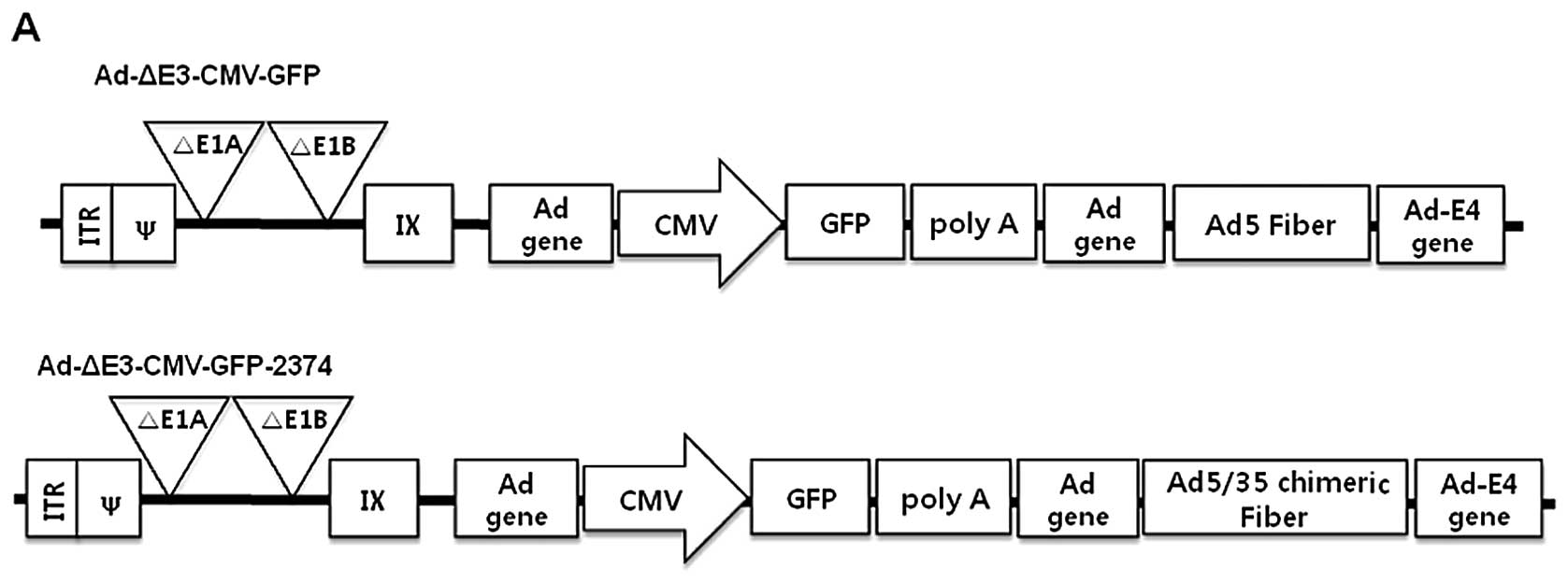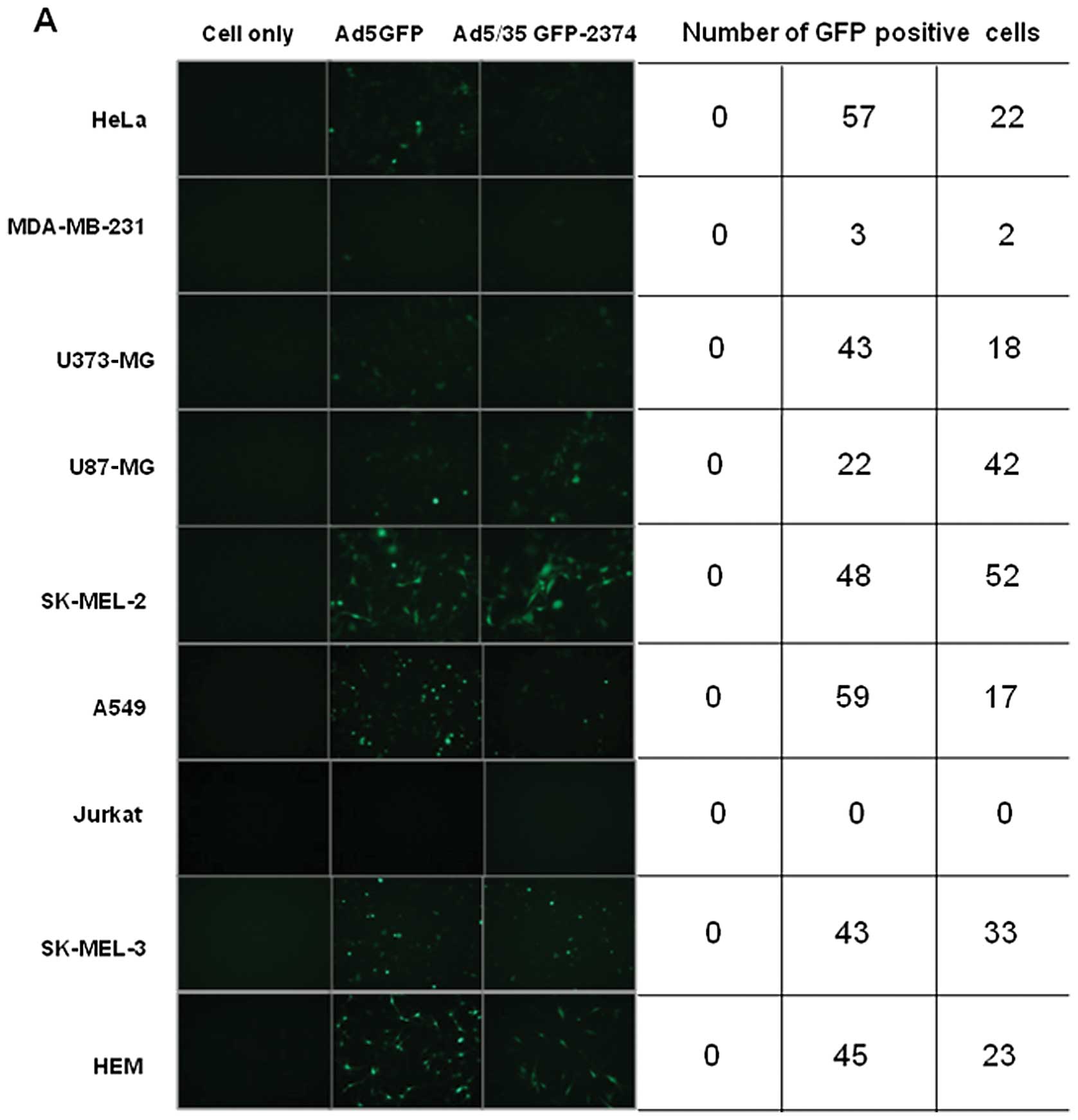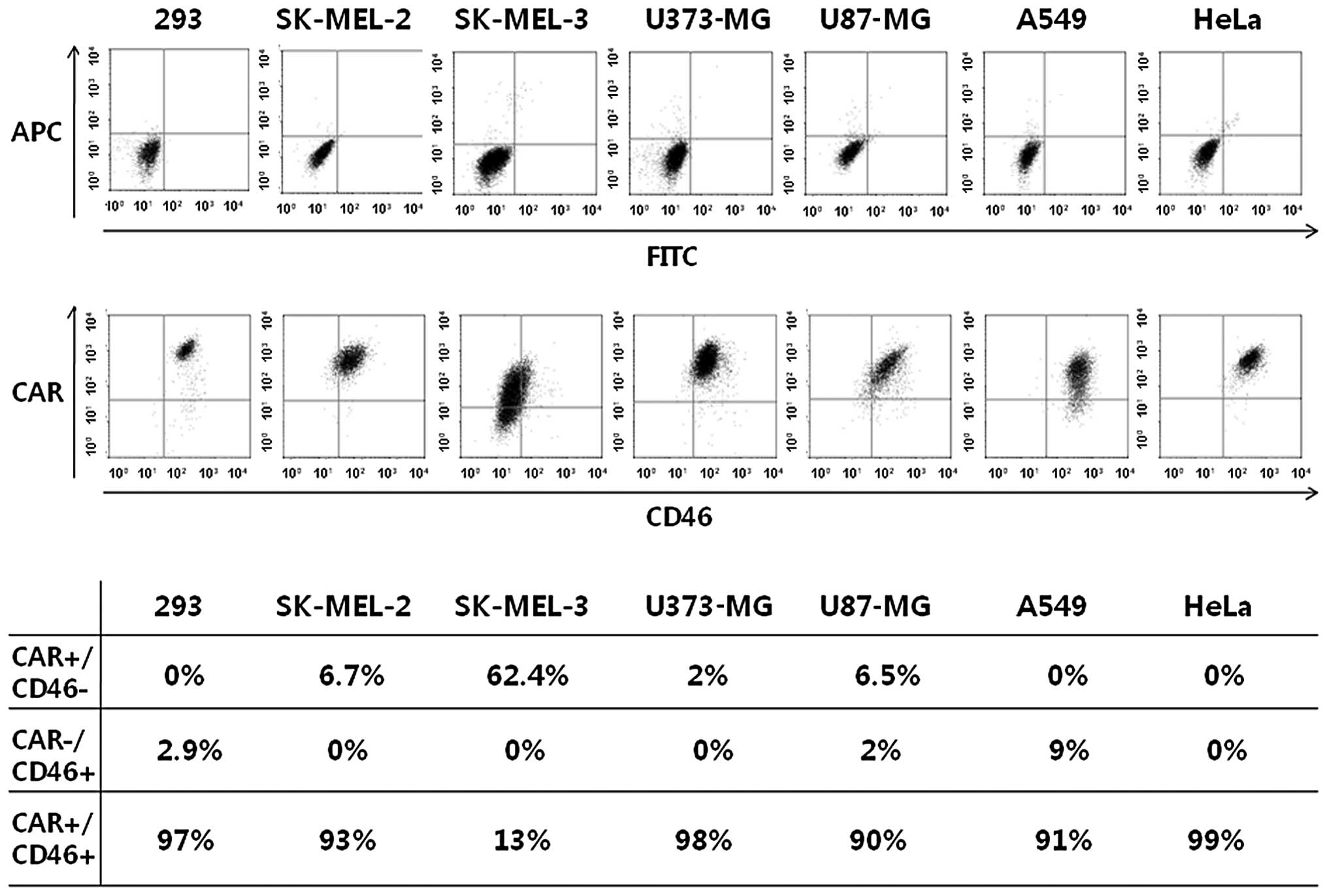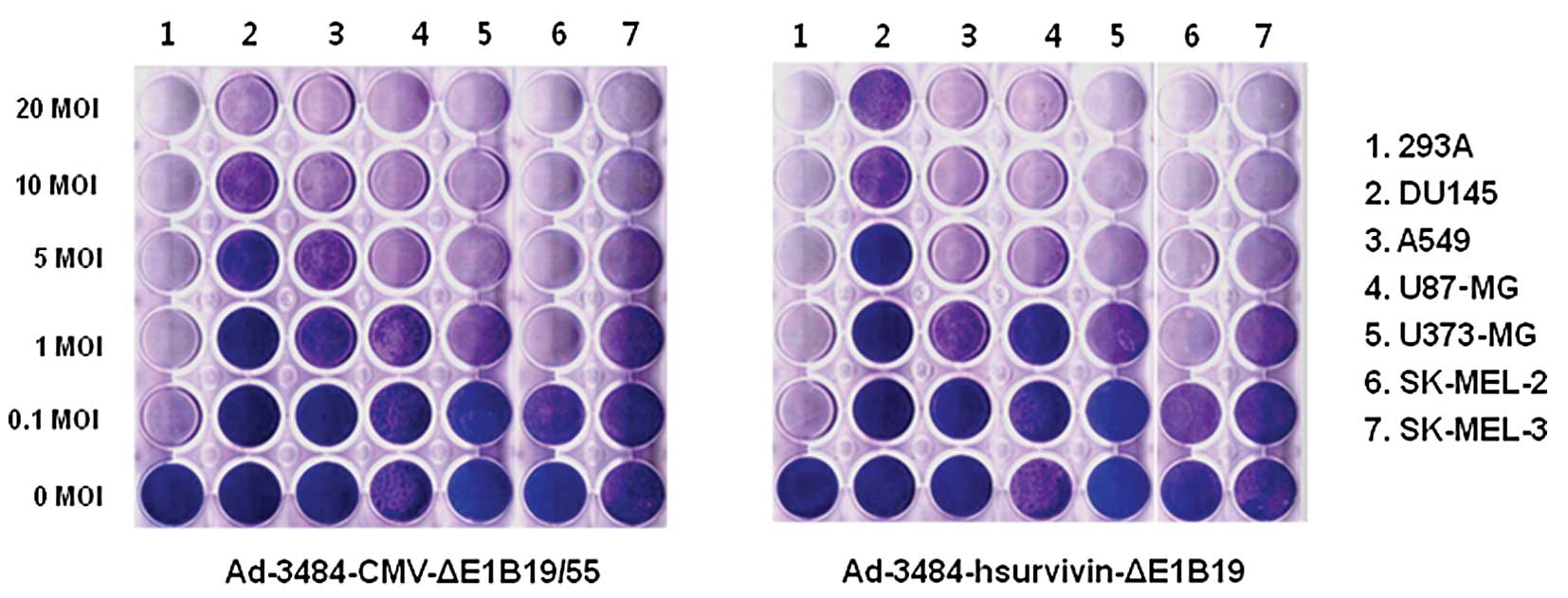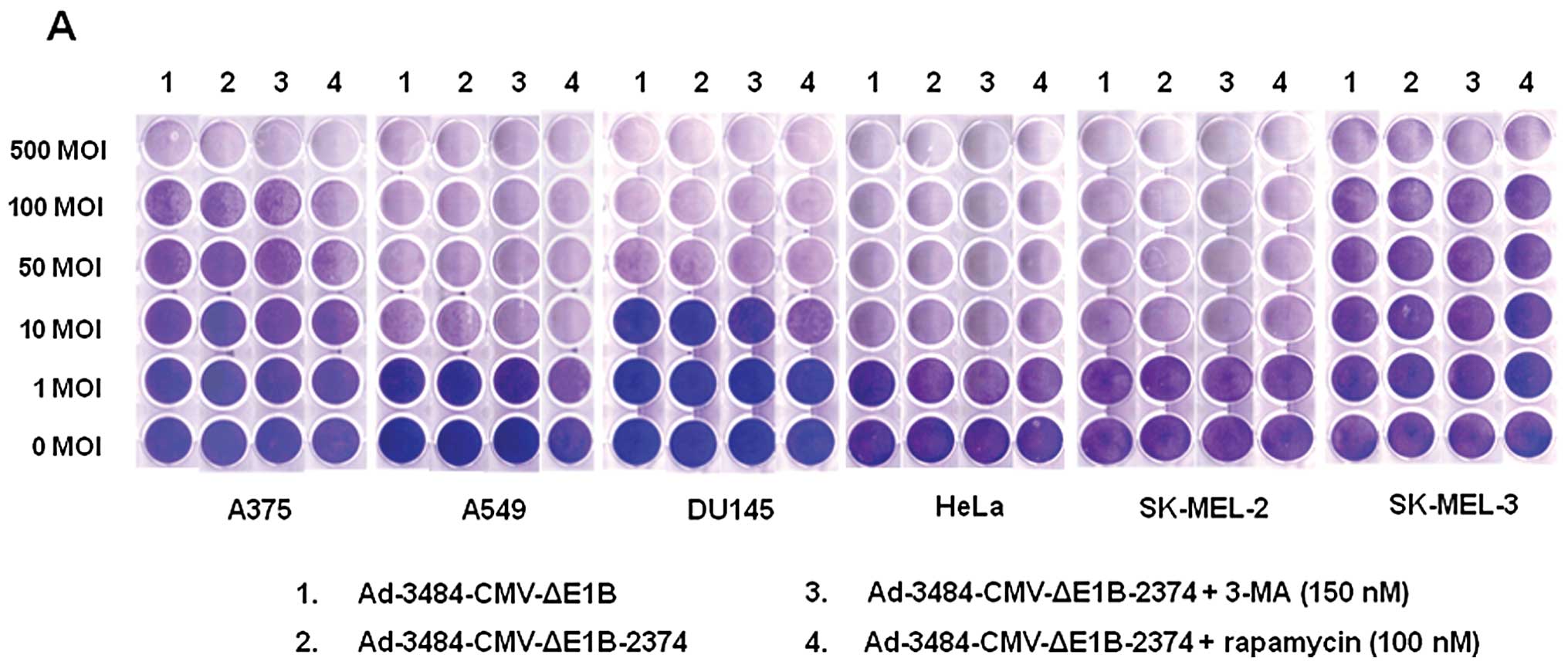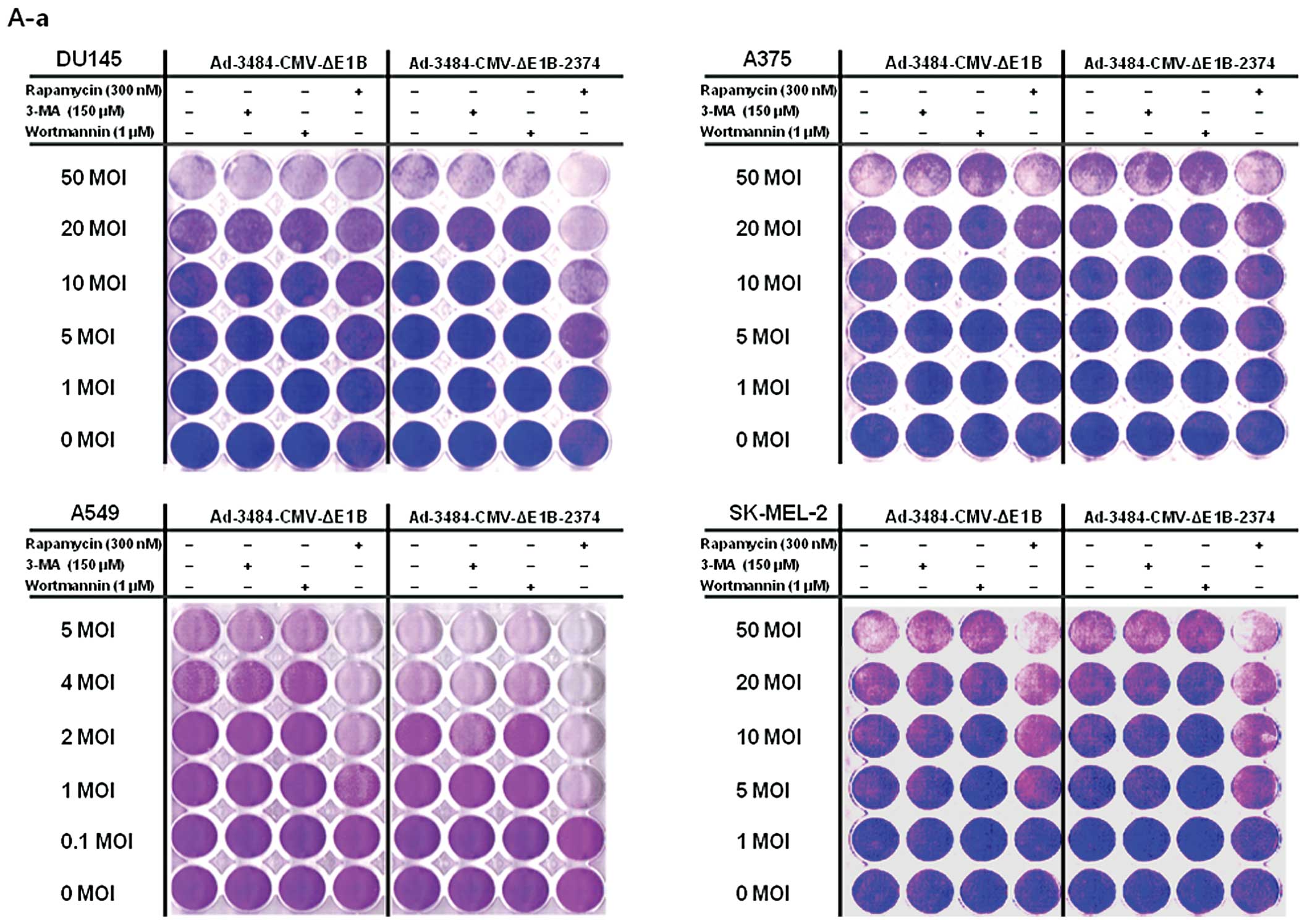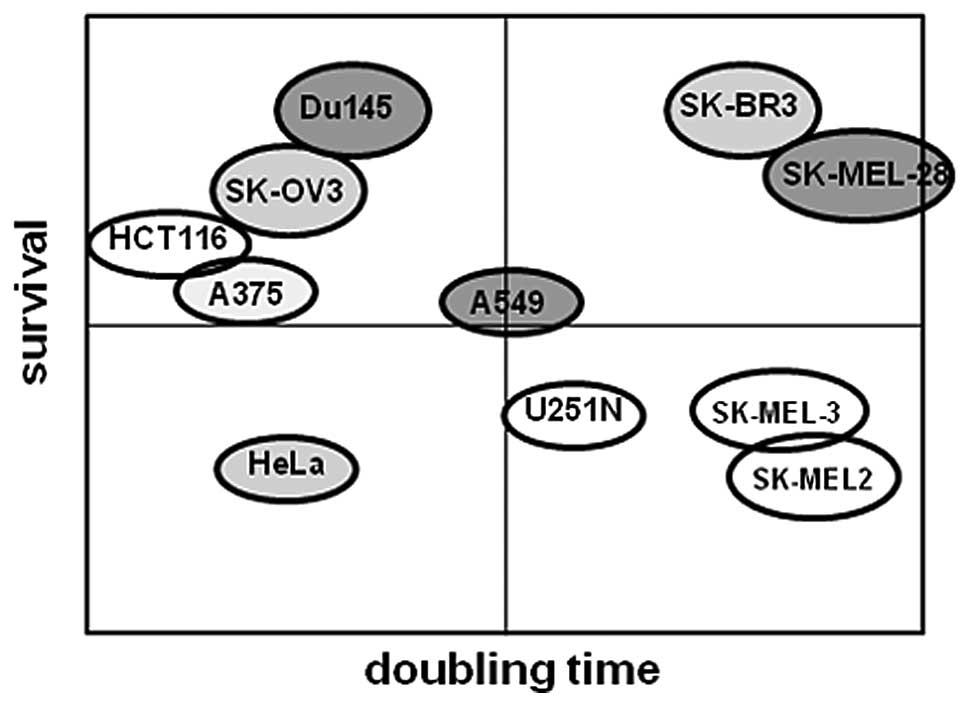|
1
|
Fukazawa T, Matsuoka J, Yamatsuji T, Maeda
Y, Durbin ML and Naomoto Y: Adenovirus-mediated cancer gene therapy
and virotherapy (Review). Int J Mol Med. 25:3–10. 2010.PubMed/NCBI
|
|
2
|
Sharma A, Tandon M, Bangari DS and Mittal
SK: Adenoviral vector-based strategies for cancer therapy. Curr
Drug Ther. 4:117–138. 2009. View Article : Google Scholar : PubMed/NCBI
|
|
3
|
Douglas JT: Adenoviral vectors for gene
therapy. Mol Biotechnol. 36:71–80. 2007. View Article : Google Scholar : PubMed/NCBI
|
|
4
|
Russell SJ, Peng KW and Bell JC: Oncolytic
virotherapy. Nature Biotech. 30:658–670. 2012. View Article : Google Scholar
|
|
5
|
Edukulla R, Woller N, Mundt B, et al:
Antitumoral immune response by recruitment and expansion of
dendritic cells in tumors infected with telomerase-dependent
oncolytic viruses. Cancer Res. 69:1448–1458. 2009. View Article : Google Scholar : PubMed/NCBI
|
|
6
|
Rux JJ and Burnett RM: Adenovirus
structure. Hum Gene Ther. 15:1167–1176. 2004. View Article : Google Scholar : PubMed/NCBI
|
|
7
|
Burnett RM: The structure of the
adenovirus capsid. II The packing symmetry of hexon and its
implications for viral architecture. J Mol Biol. 185:125–143.
1985.PubMed/NCBI
|
|
8
|
Wickham TJ, Segal DM, Roelvink PW, et al:
Targeted adenovirus gene transfer to endothelial and smooth muscle
cells by using bispecific antibodies. J Virol. 70:6831–6838.
1996.PubMed/NCBI
|
|
9
|
Stevenson SC, Rollence M, Marshall-Neff J
and McClelland A: Selective targeting of human cells by a chimeric
adenovirus vector containing a modified fiber protein. J Virol.
71:4782–4790. 1997.PubMed/NCBI
|
|
10
|
Zabner J, Freimuth P, Puga A, Fabrega A
and Welsh MJ: Lack of high affinity fiber receptor activity
explains the resistance of ciliated airway epithelia to adenovirus
infection. J Clin Invest. 100:1144–1149. 1997. View Article : Google Scholar : PubMed/NCBI
|
|
11
|
Chillon M, Bosch A, Zabner J, et al: Group
D adenoviruses infect primary central nervous system cells more
efficiently than those from group C. J Virol. 73:2537–2540.
1999.PubMed/NCBI
|
|
12
|
Tomko RP, Xu R and Philipson L: HCAR and
MCAR: the human and mouse cellular receptors for subgroup C
adenoviruses and group B coxsackieviruses. Proc Natl Acad Sci USA.
94:3352–3356. 1997. View Article : Google Scholar : PubMed/NCBI
|
|
13
|
Shayakhmetov DM, Papayannopoulou T,
Stamatoyannopoulos G and Lieber A: Efficient gene transfer into
human CD34(+) cells by a retargeted adenovirus vector. J Virol.
74:2567–2583. 2000.
|
|
14
|
Wickham TJ, Tzeng E, Shears LL II, et al:
Increased in vitro and in vivo gene transfer by adenovirus vectors
containing chimeric fiber proteins. J Virol. 71:8221–8229.
1997.PubMed/NCBI
|
|
15
|
Wickham TJ, Lee GM, Titus JA, et al:
Targeted adenovirus-mediated gene delivery to T cells via CD3. J
Virol. 71:7663–7669. 1997.PubMed/NCBI
|
|
16
|
Okada Y, Okada N, Nakagawa S, et al:
Fiber-mutant technique can augment gene transduction efficacy and
anti-tumor effects against established murine melanoma by
cytokine-gene therapy using adenovirus vectors. Cancer Lett.
177:57–63. 2002. View Article : Google Scholar
|
|
17
|
Mizuguchi H and Hayakawa T: Adenovirus
vectors containing chimeric type 5 and type 35 fiber proteins
exhibit altered and expanded tropism and increase the size limit of
foreign genes. Gene. 285:69–77. 2002. View Article : Google Scholar : PubMed/NCBI
|
|
18
|
Joubert PE, Meiffren G, Grégoire IP, et
al: Autophagy induction by the pathogen receptor CD46. Cell Host
Microbe. 6:354–366. 2009. View Article : Google Scholar : PubMed/NCBI
|
|
19
|
Hemmi S, Geertsen R, Mezzacasa A, Peter I
and Dummer R: The presence of human coxsackievirus and adenovirus
receptor is associated with efficient adenovirus-mediated transgene
expression in human melanoma cell cultures. Hum Gene Ther.
9:2363–2373. 1998. View Article : Google Scholar
|
|
20
|
Toyoda E, Doi R, Kami K, et al: Adenovirus
vectors with chimeric type 5 and 35 fiber proteins exhibit enhanced
transfection of human pancreatic cancer cells. Int J Oncol.
33:1141–1147. 2008.PubMed/NCBI
|
|
21
|
Yu L, Shimozato O, Li Q, et al: Adenovirus
type 5 substituted with type 11 or 35 fiber structure increases its
infectivity to human cells enabling dual gene transfer in
CD46-dependent and -independent manners. Anticancer Res.
27:2311–2316. 2007.PubMed/NCBI
|
|
22
|
Yu L, Takenobu H, Shimozato O, et al:
Increased infectivity of adenovirus type 5 bearing type 11 or type
35 fibers to human esophageal and oral carcinoma cells. Oncol Rep.
14:831–835. 2005.PubMed/NCBI
|
|
23
|
Rodriguez-Rocha H, Gomez-Gutierrez JG,
Garcia-Garcia A, et al: Adenoviruses induce autophagy to promote
virus replication and oncolysis. Virology. 416:9–15. 2011.
View Article : Google Scholar : PubMed/NCBI
|
|
24
|
Abounit K, Scarabelli TM and McCauley RB:
Autophagy in mammalian cells. World J Biol Chem. 3:1–6. 2012.
|
|
25
|
Noda T and Ohsumi Y: Tor, a
phosphatidylinositol kinase homologue, controls autophagy in yeast.
J Biol Chem. 273:3963–3966. 1998. View Article : Google Scholar : PubMed/NCBI
|
|
26
|
Asnaghi L, Bruno P, Priulla M and Nicolin
A: mTOR: a protein kinase switching between life and death.
Pharmacol Res. 50:545–549. 2004. View Article : Google Scholar : PubMed/NCBI
|
|
27
|
Calastretti A, Rancati F, Ceriani MC,
Asnaghi L, Canti G and Nicolin A: Rapamycin increases the cellular
concentration of the BCL-2 protein and exerts an anti-apoptotic
effect. Eur J Cancer. 37:2121–2128. 2001. View Article : Google Scholar : PubMed/NCBI
|
|
28
|
Ravikumar B, Berger Z, Vacher C, O’Kane CJ
and Rubinsztein DC: Rapamycin pre-treatment protects against
apoptosis. Hum Mol Genet. 15:1209–1216. 2006. View Article : Google Scholar : PubMed/NCBI
|
|
29
|
Everts B and van der Poel HG:
Replication-selective oncolytic viruses in the treatment of cancer.
Cancer Gene Ther. 12:141–161. 2005. View Article : Google Scholar : PubMed/NCBI
|
|
30
|
Guo ZS, Thorne SH and Bartlett DL:
Oncolytic virotherapy: molecular targets in tumor-selective
replication and carrier cell-mediated delivery of oncolytic
viruses. Biochim Biophys Acta. 1785:217–231. 2008.PubMed/NCBI
|
|
31
|
Wu L, Johnson M and Sato M:
Transcriptionally targeted gene therapy to detect and treat cancer.
Trends Mol Med. 9:421–429. 2003. View Article : Google Scholar : PubMed/NCBI
|
|
32
|
Diepgen TL and Mahler V: The epidemiology
of skin cancer. Br J Dermatol. 146(Suppl 61): 1–6. 2002. View Article : Google Scholar
|
|
33
|
Lu B, Makhija SK, Nettelbeck DM, et al:
Evaluation of tumor-specific promoter activities in melanoma. Gene
Ther. 12:330–338. 2005. View Article : Google Scholar : PubMed/NCBI
|
|
34
|
Yun CO, Cho EA, Song JJ, et al:
dl-VSVG-LacZ, a vesicular stomatitis virus glycoprotein
epitope-incorporated adenovirus, exhibits marked enhancement in
gene transduction efficiency. Hum Gene Ther. 14:1643–1652. 2003.
View Article : Google Scholar
|
|
35
|
Yun CO, Kim E, Koo T, Kim H, Lee YS and
Kim JH: ADP-overexpressing adenovirus elicits enhanced cytopathic
effect by induction of apoptosis. Cancer Gene Ther. 12:61–71. 2005.
View Article : Google Scholar : PubMed/NCBI
|
|
36
|
Baird SK, Aerts JL, Eddaoudi A, Lockley M,
Lemoine NR and McNeish IA: Oncolytic adenoviral mutants induce a
novel mode of programmed cell death in ovarian cancer. Oncogene.
27:3081–3090. 2008. View Article : Google Scholar : PubMed/NCBI
|
|
37
|
Ito H, Aoki H, Kühnel F, et al: Autophagic
cell death of malignant glioma cells induced by a conditionally
replicating adenovirus. J Natl Cancer Inst. 98:625–636. 2006.
View Article : Google Scholar : PubMed/NCBI
|
|
38
|
Jiang H, Gomez-Manzano C, Aoki H, et al:
Examination of the therapeutic potential of Delta-24-RGD in brain
tumor stem cells: role of autophagic cell death. J Natl Cancer
Inst. 99:1410–1414. 2007. View Article : Google Scholar : PubMed/NCBI
|
|
39
|
Jiang H, White EJ, Gomez-Manzano C and
Fueyo J: Adenovirus’s last trick: you say lysis, we say autophagy.
Autophagy. 4:118–120. 2008.
|
|
40
|
Wu YT, Tan HL, Shui G, et al: Dual role of
3-methyladenine in modulation of autophagy via different temporal
patterns of inhibition on class I and III phosphoinositide
3-kinase. J Biol Chem. 285:10850–10861. 2010. View Article : Google Scholar : PubMed/NCBI
|
|
41
|
Shayakhmetov DM, Li ZY, Ternovoi V, Gaggar
A, Gharwan H and Lieber A: The interaction between the fiber knob
domain and the cellular attachment receptor determines the
intracellular trafficking route of adenoviruses. J Virol.
77:3712–3723. 2003. View Article : Google Scholar
|



